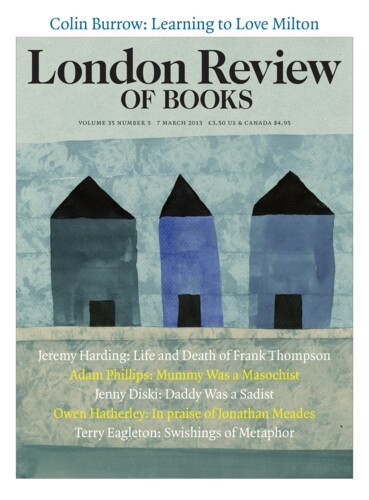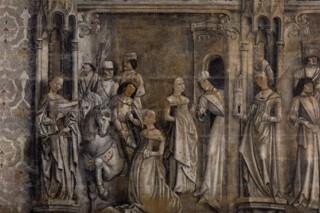Henry VI had an unusually long reign, but on most counts a singularly unfortunate one. He lost the lands gained in France by his father Henry V, he became embroiled in the Wars of the Roses, his son was killed and he himself died in mysterious circumstances as a prisoner in the Tower of London. Although lacking the qualities required in an effective monarch, he proved to be an outstanding patron of education, founding Eton College in 1440 and in the following year a college in Cambridge, now known as King’s College. His main motivation was an intense piety. The huge chapel at King’s, which took nearly a century to build, is as big as Henry intended, but Eton College Chapel, which he wanted to be even bigger, was never completed in the form that he planned. The chapel as it exists today is only the choir of a church which would have included a nave. Dedicated to the Virgin, it was intended to be a major centre for pilgrimage, and Henry endowed it with many valuable relics, including some of the Virgin’s milk.
When the original scheme was abandoned, a screen was constructed across the existing building, dividing the east end – with the altar and space for the clergy and scholars – from the west, which was for the laity, including pilgrims. In the years around 1480 the side walls of this area were each decorated with two rows of narrative paintings, one above the other, with the individual scenes divided by painted architectural frames and painted statues of prophets and saints. Covered in whitewash in 1560, the paintings were accidentally rediscovered in 1847, when the school’s clerk of the works had the upper row on each side eliminated before he was stopped. The surviving scenes were then obscured by wooden stalls until 1923. Only then, through the efforts of the provost of Eton, M.R. James, now best known for his ghost stories, were the paintings once more revealed and restored, in the first of several such campaigns.
Although they have been known to specialists (and Etonians) since that time, few people are aware that they comprise the largest surviving set of wall paintings of the 15th century from anywhere in northern Europe. Perhaps this explains why in 1847 they were thought to be Florentine. But the Gothic architectural frames, the costumes and the style of the figures point unmistakably to the art of Flanders, and especially to the work of artists like Rogier van der Weyden and Dieric Bouts. There were clearly two main painters at Eton, one working on the north wall and the other on the south, and perhaps a third who was responsible for the paintings at the west on both sides, but whether they were Flemish or merely trained in Flanders has not been established. Despite the understandably poor or indifferent state of preservation of some areas, enough survives of the paintings, which were executed largely in grisaille enlivened with other colours, to show that these are the finest existing works of this period in England, and of much more than provincial significance.
Most viewers familiar with western European art will recognise some of the saints, such as Catherine with her wheel or Barbara with her tower, but others – Sidwell, for example, a martyr from Exeter beheaded by reapers at the instigation of her stepmother – must always have been more difficult to identify. Almost everyone today will be baffled by the narrative scenes, which show miracles of the Virgin. Several illustrate the good effects of venerating images of the Virgin. On the south wall the adventures of an empress falsely accused of infidelity and then infanticide are shown in eight episodes. Abandoned on a deserted island, she was rescued by the intervention of the Virgin, who also revealed a herb to her which had the power of healing leprosy. Unsurprisingly, her persecutors contracted the disease, but she was able to heal them after they had confessed their misdeeds. Finally, she became a nun. These miracles were taken from two of the most common medieval books, the Golden Legend of Jacobus de Voragine and the Speculum Historiale of Vincent of Beauvais. They were not often represented outside England in the 15th century, and never before, so far as is known, on this scale, but they must have been familiar to many of the pious pilgrims to whom they were addressed. In an educational institution they now seem rather incongruous.
More appropriate to the context is another wall painting discovered at Eton in 2005, this time behind some panelling in what was originally the headmaster’s room. It seems to have been painted around 1520, and survives in very ruinous condition, but it is the only work of its kind known anywhere in Europe. In the centre a schoolmaster, identified by the book and birch that he holds, is shown seated on a chair of distinctively Renaissance design, surrounded by a group of diminutive schoolboys participating in a lesson. Above are edifying inscriptions derived from Cicero and Quintilian, but taken directly from a school book composed by one of the fellows of Eton, and from the Bible (‘Spare the rod and spoil the child’).
Compared with the paintings in the chapel, the scene with the schoolmaster is rather primitive, showing no evidence of Flemish influence or involvement. It seems instead to be derived from English woodcuts showing teachers and students, but the children are lively and strongly differentiated one from another in character and behaviour. The result is a unique depiction of school life in Renaissance England. Now, with the publication of Wall Paintings of Eton (Scala, £35) which includes a full set of excellent illustrations and up-to-date scholarly texts covering technical as well as art-historical issues, the significance in the history of English art of this strange picture and the surviving murals in the chapel can be properly appreciated.
Send Letters To:
The Editor
London Review of Books,
28 Little Russell Street
London, WC1A 2HN
letters@lrb.co.uk
Please include name, address, and a telephone number.


